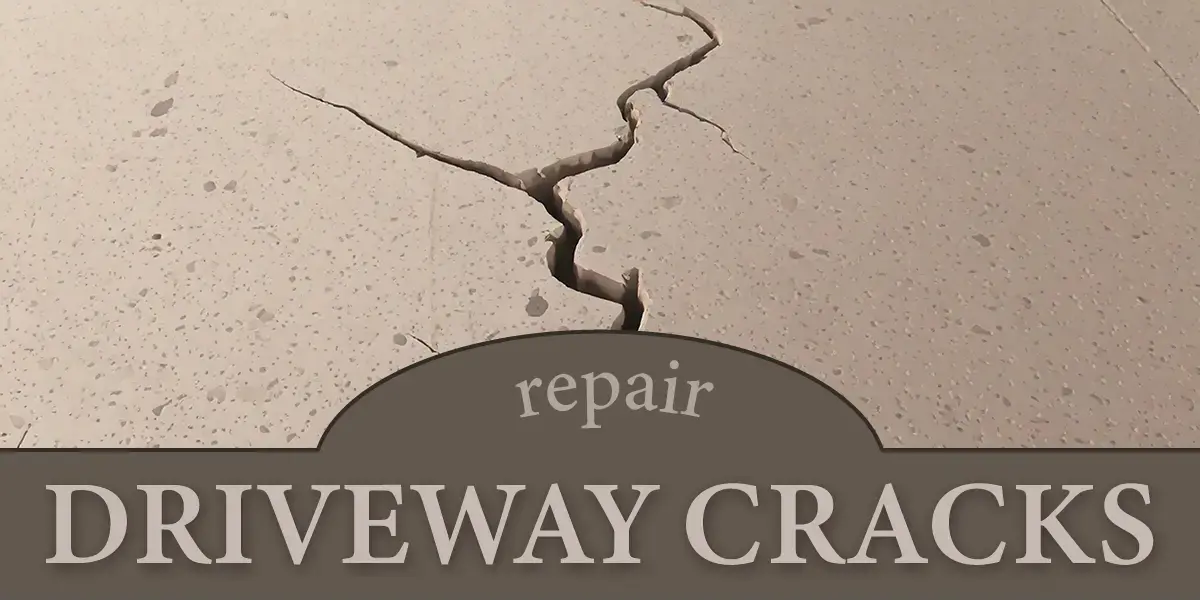An asphalt driveway will last between 15 and 30 years. A concrete driveway may last 20 to 50 years, with an average expectancy of about 30 years.
Climate, use, maintenance, and installation quality significantly impact driveway lifespan.
You can’t control the weather or build quality of a driveway installed a decade ago. But regular maintenance, like seal coating every few years and repairing cracks promptly, is 100% within your control and will extend the life of any driveway.
Factors That Shorten Driveway Lifespan
- Climate and Weather Conditions: Extreme temperatures, freeze-thaw cycles, and heavy precipitation can expand and contract driveway materials, leading to cracks and deterioration.
- Poor Installation: Inadequate site preparation, improper mixing, or insufficient thickness can compromise a driveway’s structural integrity.
- Lack of Maintenance: Neglecting regular maintenance, such as sealing cracks, cleaning, and seal coating, allows minor issues to escalate into significant damage.
- Heavy Loads and Traffic: Frequent exposure to heavy vehicles or traffic can stress the driveway surface.
- Improper Drainage: Poor drainage leads to water pooling, which can penetrate and weaken the driveway’s material.
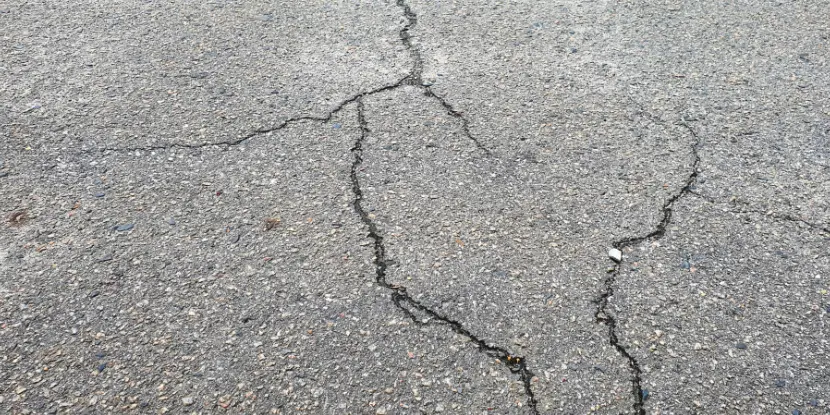
Driveway cracks will spread rapidly if left untreated.
Why Should You Fix Driveway & Pavement Cracks?
From water damage to weed growth, these minor imperfections can quickly escalate into costly repairs. The good news? You don’t have to be a professional to fix them.
Consider the following:
- Cracks allow rainwater to seep in, eroding the foundation below and causing structural damage.
- Unsealed cracks create the perfect environment for weeds, further widening the damage.
- A smooth, sealed surface instantly boosts your property’s curb appeal and value.
- Fixing small cracks now can help you avoid much more expensive repairs later.
Tools & Materials You’ll Need
Asphalt Repairs
- Asphalt crack filler (cold pour or heat-activated)
- Trowel or putty knife
- Wire brush
- Push broom or leaf blower
- Caulk gun (if needed for filler application)
- Sealant (if sealing the entire surface afterward)
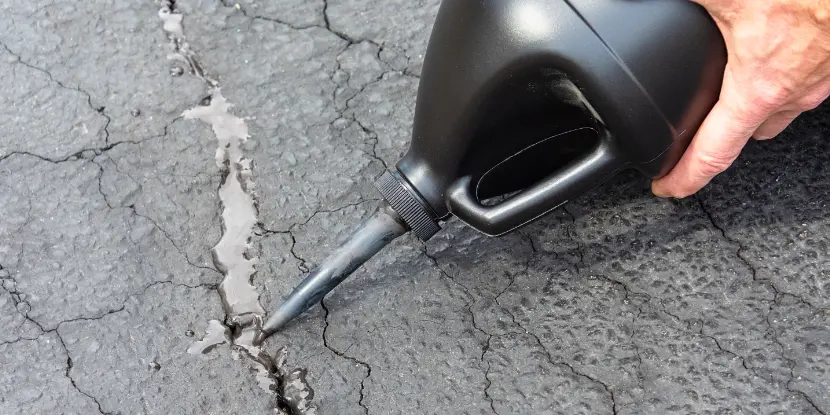
Applying asphalt crack filler with a nozzle.
Concrete Repairs
- Concrete patching compound or crack filler
- Trowel or putty knife
- Wire brush or chisel
- Bucket of water
- Sponge
- Caulk gun (optional, for thinner cracks)
Optional but helpful tools for either surface:
- Safety gloves and goggles
- Heat gun (for heat-activated fillers)
- Sand to fill larger holes
How to Repair Cracks in Asphalt
1. Clean the Crack
Start by thoroughly cleaning the crack and surrounding area. Ensuring the crack is clean will help the filler adhere properly.
- Use a wire brush to remove debris like dirt, weeds, or loose asphalt.
- Remove any dust or small particles with a push broom or leaf blower.
2. Fill the Crack
- Cold-pour filler works best for small cracks (less than 1/2 inch wide). Squeeze it into the crack using a caulk gun or directly from the bottle.
- For larger cracks, apply a trowelable filler to patch the gap evenly.
Tip: Slightly overfill the crack to allow for settling as it dries.
3. Smooth & Level
Use a trowel to flatten the filler flush with the surrounding pavement.
4. Curing & Sealing
- Allow the filler to cure according to the manufacturer’s instructions.
- Once cured, consider applying an asphalt sealant to enhance durability and create a more polished look.
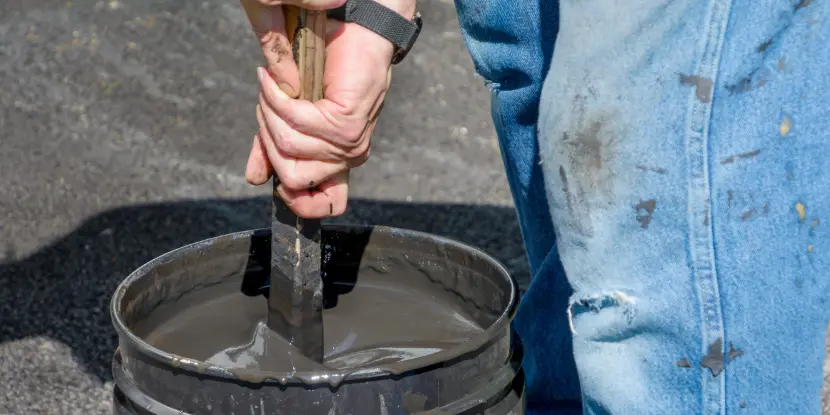
A DIYer stirring a bucket of asphalting material.
How to Repair Cracks in Concrete
1. Prepare the Crack
- Use a wire brush or a chisel to clear the crack of any loose concrete, dirt, or weeds.
- Rinse the crack with water to remove dust and debris. Use a sponge to soak up any excess water, leaving the crack slightly damp but not wet.
Tip: Damp cracks help the patching compound adhere better.
2. Apply the Filler or Patching Compound
- Use a liquid concrete crack filler for cracks less than 1/4 inch wide. Squeeze it into the crack and smooth it with a trowel.
- Mix a concrete patching compound for larger cracks. Use your trowel to fill the crack, pressing the compound into any crevices.
3. Smooth & Level
After filling, smooth the surface to ensure it blends with the surrounding concrete.
4. Curing
- Allow the compound to cure completely. Depending on the product, this could take 24–48 hours.
- Avoid walking or driving on the repaired area until it has completely set.
Bonus Tips for Long-Lasting Repairs
- Perform repairs when the forecast is clear. Rain or extreme heat can interfere with curing.
- Small cracks are easier to repair than larger ones, so regularly inspect your driveway or pavement for new damage.
- Sealing your driveway every 1–3 years can significantly extend its lifespan.
- Cheaper fillers and compounds may save money initially, but premium products last longer and provide better results.
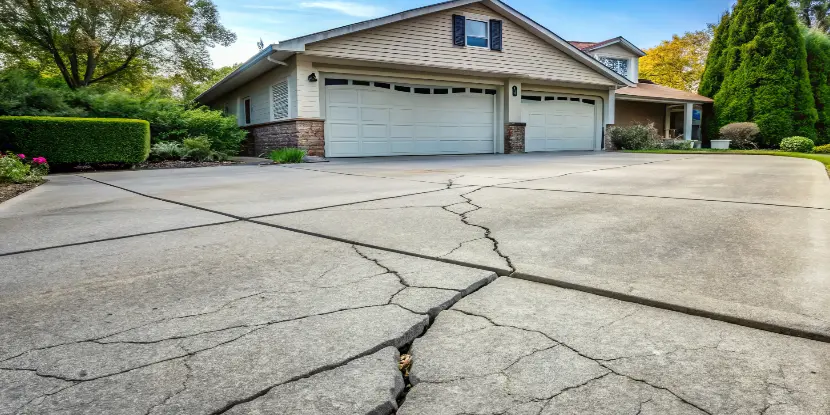
This badly cracked concrete driveway will need professional repair and partial replacement.
FAQs: Fixing Driveway Cracks
Q: How long does a driveway repair take?
The repair process can take anywhere from 15 minutes to several hours, depending on the severity of the damage and the product used. Curing time also varies based on product and weather conditions.
Q: Can I fill driveway cracks myself, or do I need a professional?
Homeowners can fix most small cracks with minimal tools and experience. However, it’s best to hire a professional for larger cracks or significant damage.
Q: Do I need to seal my repaired driveway afterward?
It’s not necessary but highly recommended for added protection and longevity. Sealing helps prevent water penetration and further cracking.
Q: How often should I repair and seal my driveway?
Inspect your driveway annually for cracks or damage. Sealing it regularly every 1–3 years can significantly extend its lifespan.
Q: What’s the best time of year to repair driveway cracks?
The ideal time to repair driveway cracks is during mild weather, typically in spring or early fall. Extreme temperatures, whether hot or cold, can affect the curing process and the effectiveness of the filler or sealant.
Q: Can I use the same filler for asphalt and concrete cracks?
No, asphalt and concrete require different types of fillers. Using the wrong filler can lead to poor adhesion and may not provide a lasting repair. Always check the product label to ensure compatibility with your driveway material.
Q: How do I prevent weeds from growing in cracks?
Thoroughly clean and properly fill cracks during the repair process. Applying a high-quality sealant over the surface can also block weed growth by reducing moisture seepage and sunlight exposure to the crack.
Q: Are driveway crack repairs permanent?
Over time, weather, traffic, and natural wear and tear may cause new cracks to form. Regular maintenance and sealing will ensure your driveway remains in good condition for as long as possible.

